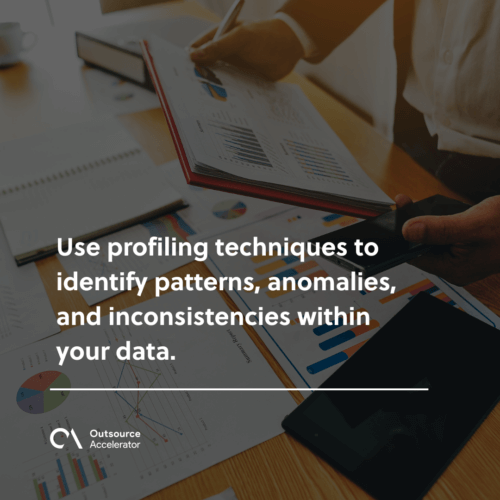Your 7-step checklist for conducting data quality checks

Data is the lifeblood of modern businesses. At best, it drives crucial decision-making processes in every aspect it is applied to.
But, without ensuring its quality, you may be basing your decisions on unreliable information.
Picture this: you use your marketing data to analyze buying patterns and personalize campaigns. If this contains inaccuracies and duplicates, you might form campaigns that will not relate much to your audience.
Gartner revealed that organizations spend an average of $12.9 million annually on bad data. What’s more, data engineers spend much effort fixing them and be put to use.
This is where data quality checks come into play – to clean up your data and ensure its high quality.
Learn about the seven-step checklist for conducting data quality checks. These procedures can help you maintain top-quality data that drives your business forward.
How do data quality checks work?
Data quality checks are done to test data quality and identify what factors lead to poor quality. It involves resolving issues affecting accuracy, completeness, consistency, and reliability.
Several issues impact your data as it goes through your production, whether by mistake or in nature.
Data quality checks use various techniques to ensure the quality of your data throughout. This includes data profiling, data cleansing, and data validation.

When do you need data quality checks: 7 common issues
A study by MIT Sloan showed that bad data costs around 15% to 20% of company expenses. It is crucial to identify the causes of this bad data and prevent them to lessen costs in the long run.
Here are seven situations where data quality checks are particularly important:
1. Data inconsistencies
Inconsistent data can occur when multiple sources provide conflicting information or when data is entered manually with variations.
Quality checks help identify and resolve inconsistencies, ensuring your data is reliable and accurate.
2. Missing or incomplete data
Missing or incomplete data can hinder decision-making and analysis. By conducting quality checks, you can identify and rectify any gaps in your data, ensuring its completeness and usability.
3. Duplicate information
Duplicate entries from different sources can lead to confusion and inaccuracies.
Data quality checks can help you merge duplicate records. This enhances data accuracy and reduces redundancy on your part.
4. Outliers and anomalies
Outliers and anomalies in data can impact analysis and reporting.
Data quality checks help detect any irregularities your data has. This allows you to address them and maintain your data’s integrity.
5. Data validation failures
Data validation ensures that data adheres to predefined rules and standards. However, you might face challenges in validating them with the following factors:
- Recent changes are made manually
- Duplicate data from another source exists
- The latest information indicated conflicts with their existing one
Quality checks highlight any failures that must be addressed to ensure data reliability.
6. Data integrity issues
Data integrity determines how you maintain the consistency of information throughout its lifecycle.
Data quality checks are vital in identifying and resolving any integrity issues you encounter. This helps you guarantee its trustworthiness within its cycle.
7. Compliance requirements
Compliance with industry standards is essential for organizations dealing with sensitive information. You might face the consequences of mishandling health or financial data and not complying with HIPAA or PCI certification.
By conducting data quality checks, you can ensure your data meets the compliance standards applied to it. It can further save you from penalties and legal issues.
7 steps in conducting data quality checks
Companies may have different ways to execute quality checks aligned with their standards. Yet, they follow a similar framework for conducting this in their organizations.
Let’s delve into the seven-step checklist for conducting data quality checks.
1. Define data quality goals
Start by identifying the specific data quality goals you want to achieve. This involves understanding your business objectives, data requirements, and the level of quality necessary for accurate decision-making.
2. Identify key elements
Determine the critical data elements for your organization’s operations and decision-making processes.
You can categorize your data according to sensitivity, disclosure, and use. Some of the groups to classify include:
- Customer information
- Financial data
- Inventory details
- Marketing campaigns
- Sales reports
3. Establish quality metrics
Create metrics to measure the quality of your data. Usually, data is measured according to accuracy, completeness, consistency, timeliness, and validity.
These metrics will serve as benchmarks for evaluating the effectiveness of your data quality checks.
4. Develop data profiling processes
Data profiling involves analyzing data to understand its structure, quality, and relationships. Use profiling techniques to identify patterns, anomalies, and inconsistencies within your data.

5. Apply data cleansing techniques
Data cleansing aims to correct or remove any errors, inconsistencies, or inaccuracies in your data. This step involves techniques like standardization, deduplication, and formatting to enhance your data’s overall quality and reliability.
6. Perform data validation
Data validation ensures that data conforms to predefined rules, constraints, and formats. Implement validation processes to verify your data’s accuracy, integrity, and validity.
7. Establish ongoing data quality monitoring
Maintaining data quality is an ongoing process. Set up regular monitoring mechanisms to track the quality of your data over time. This includes periodic assessments and audits to ensure consistency.
Maintaining top quality through consistent data quality checks
Consistent data quality checks are necessary to maintain your data in tip-top shape. Following the checklist above helps ensure your data remain accurate, reliable, and trustworthy.
Remember, your data is an invaluable asset. Investing in data quality checks is essential for unlocking its full potential. Data quality requires ongoing attention and effort to uphold the integrity of your data and drive business success.







 Independent
Independent




